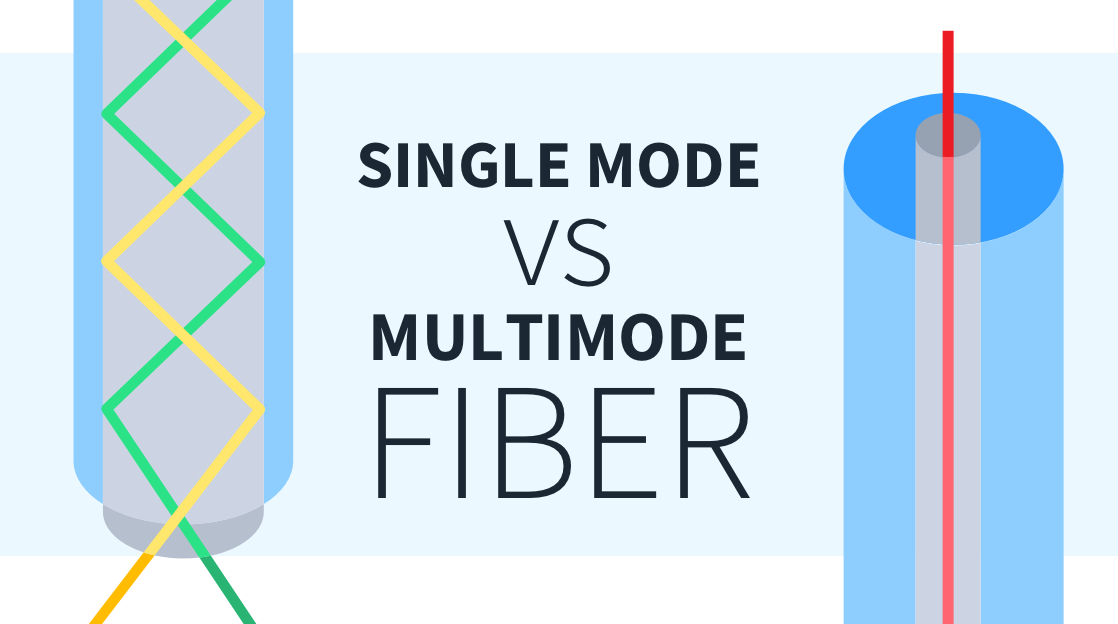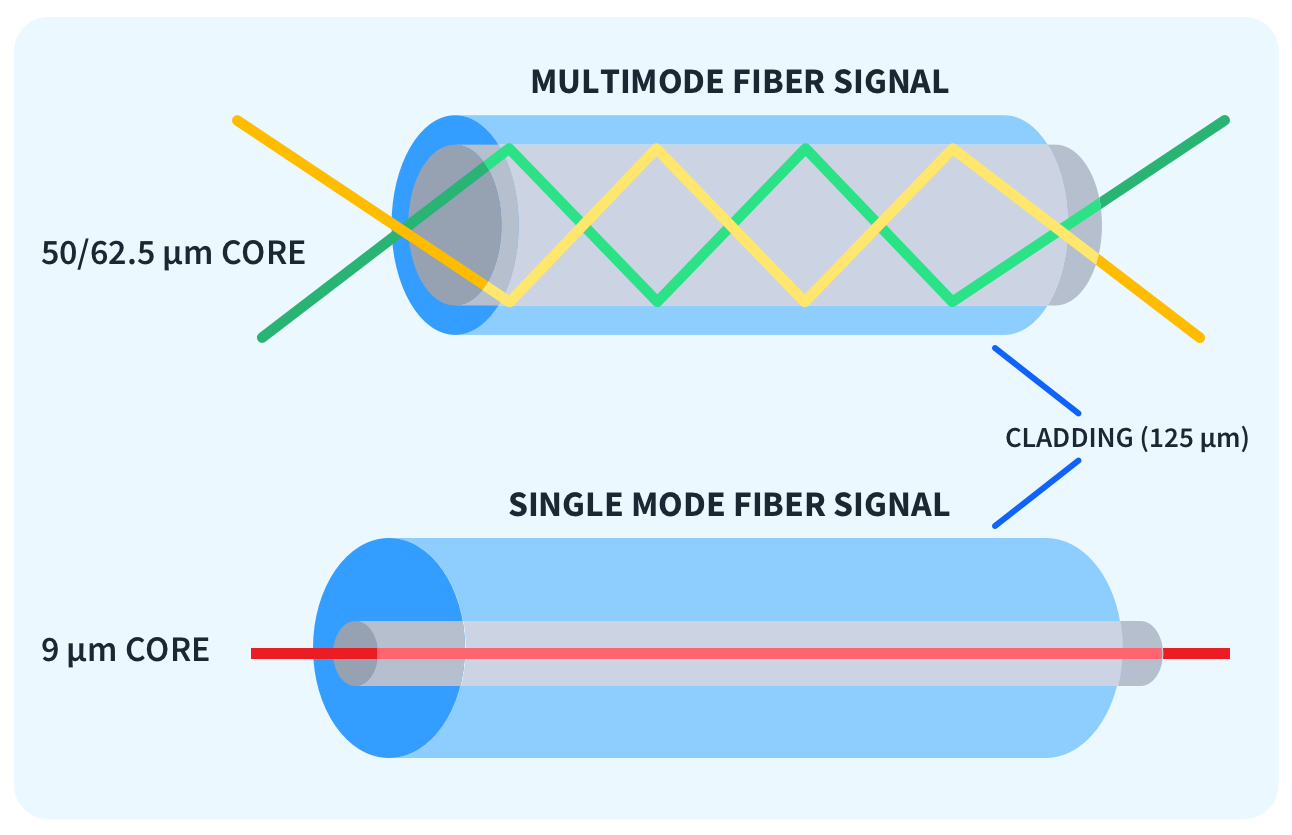Single Mode vs Multimode Fiber: What are the Differences?

In today's data-driven world, the choice between single mode and multimode fiber optic technology is crucial to building an effective network infrastructure. It is so significant that it consistently shows up on the Network+ exam as a core concept. When searching for an effective means of data transmission, consider fiber optics as your top choice.
Fiber optics enables data transmission at close to the speed of light and is employed as a long-distance medium for data transfer across vast distances, including across oceans. It can also be a reliable solution for short-distance communication within a LAN.
However, you might not know whether single-mode or multi-mode is the best solution for your situation. Single mode vs. multimode fiber differs primarily in how they transmit light (i.e., data). Let’s begin by clarifying the differences between single mode and multimode fiber, starting with single mode.
What is Single Mode Fiber?
Single mode fiber (SMF) has one core in which light is transmitted, and has far greater transmission distances than multimode.

The hallmark feature of single mode fiber is its core size. Single mode fiber has a far smaller core size compared to multimode fiber, measuring in at only 8 to 10 micrometers. The minuscule diameter reduces signal loss, which facilitates long-distance communication.
Single mode fiber usually uses laser diodes as a light source. The monochromatic nature of laser light means it emits at a single, predictable wavelength. Single mode fiber optics is also coherent. Coherent in this context means the light waves are synchronized and maintain a consistent phase relationship. Light coherence is crucial for long distance light travel.
Single mode fiber optics is the more expensive of the two modes, but it transmits data at much farther rates. That’s why it’s used to transmit data under the ocean or to connect residential neighborhoods. In fact, the entire backbone of the internet relies on single mode fiber optics.
What are the Advantages of Single Mode Fiber?
The biggest advantage of single mode fiber is its transmission distance. While the maximum distance traveled can vary based on several factors, a single mode fiber optics can often travel up to 100 KM without signal regeneration. This distance far exceeds multimode fiber optics, or any other cabling solution, for that matter.
Single mode fiber also has high bandwidth. It is optimal for network-intensive activities such as VoIP, streaming movies, and high-capacity file transfers. This is because of the low attenuation (i.e., signal loss) of single mode fiber optics.
Ultimately, single mode fiber is well-suited for undersea communication cables, datacenter communication, and other critical infrastructures that need speedy response times over long distances. This is mainly because of its biggest disadvantage: the cost of implementation.
What are the Limitations of Single Mode Fiber?
The biggest limitation of single mode fiber is the cost of implementation. The transmitters and receivers required for single mode fiber optics far exceed the cost of respective multimode equipment.
Installing single-mode fiber optics is a complex and time-consuming process. While single mode fiber can be bent to some extent, it has tighter bend radius requirements, adding complexity to the installation process. High degrees of precision, careful handling, and specifically trained professionals are necessary for a successful installation.
What is Multimode Fiber?
Multimode fiber (MMF) transmits multiple rays of light (or modes) simultaneously. It is used primarily to transmit data over short to medium ranges. The maximum distance can vary widely depending on which fiber optics type is used. The four types are OM1, OM2, OM3, and OM4.

Multimode fiber optics has a larger core size than its single mode counterpart, generally around 50 micrometers. Due to the relatively large size of the core, incoherent light sources such as LEDs can easily be used to transmit data. LED light emission does not require the same level of precision as single mode.
Multimodes fiber optics allows multiple streams of light to travel simultaneously. This hallmark characteristic provides high bandwidth for small to medium distances. Multimodes are ideal for LANs due to their low cost, relatively simple setup, and high bandwidth.
What are the Advantages of Multimode Fiber?
Multimode fiber has numerous advantages, ranging from ease of installation, cost, and lightsource compatibility. MMF’s larger core size makes it easy to install and guide through walls. Transceivers, connectors, and patch cables for MMF are far less expensive than for SMF.
Bandwidth on MMF is typically excellent and would be more than enough for any LAN. Of course, the bandwidth differs depending on which technology is used, from OM1 to OM4. Here is a convenient chart listing the key differences between each of the MMF technologies:
Parameter | OM1 | OM2 | OM3 | OM4 |
Core Diameter | 62.5 micrometers | 50 micrometers | 50 micrometers | 50 micrometers |
Bandwidth | 200 MHz·km | 500 MHz·km | 2000 MHz·km | 4700 MHz·km |
Max Data Rate | 1 Gbps | 1 Gbps | 10 Gbps | 10 Gbps |
Max Distance | 275 Meters | 550 Meters | 550 Meters | 1000 Meters |
Applications | Legacy LAN | Legacy LAN | High-Speed LAN. Campus backbone | Campus Backbone, High speed LAN. |
The max data rate and bandwidth are related concepts but still distinctly different. In short, data rate is the amount of data pushed through the wire, while bandwidth is a measure that is more of a theoretical data rate limit based on frequency.
In summary, MMF is a cost-effective solution for any LAN requiring lightning-quick data transfer rates.
What are the Limitations of Multimode Fiber?
The biggest drawback to multimode fiber is its poor performance over long distances. Single mode fiber optics is your best route if you need high speeds at long distances. Multimode Fiber can experience signal degradation due to overlapping light streams. This can result in significant signal degradation over long distances. Lastly, as the demand for higher-speed internet increases, MMF will lack the future-proofing already inherent in single mode fiber optics.
Despite some limitations of multimode fiber, it still remains a cost-effective solution for LANs, datacenters, and other on-premise networks.
Single Mode Vs. Multimode Fiber: Choosing the Right Option
Several factors should be taken into account before deploying a fiber optics network. The most obvious is distance requirements. If the network needs to span from one data center to another across town (or continents), then go with SMF. If the fiber optics will be used on a LAN, then OM4 fiber optics is the best solution.
If you already have network equipment for SMF, it may be easier to leverage existing resources and use single mode for your network. (After all, nothing says you can’t use SMF for a LAN.)
Another consideration is cost. If money is no object, then single mode fiber optics is worth considering due to its redundancy, bandwidth, and data rate.
Data security is another aspect to consider. If the LAN is top secret, or requires some degree of privacy, then SMF is the way to go. SMF is far more resistant to signal interference and eavesdropping.
Overall, MMF is the best solution for a standard LAN – but it is certainly worth looking into SMF and seeing how it would fit into your network and budget.
Conclusion
The differences between single mode vs multimode fiber should be considered before setting up a LAN or WAN. Furthermore, all differences should be thoroughly understood before tackling the Network+ Exam. Multimode fiber optics is the most practical solution for a LAN, offering high-speed data rates at a manageable cost.
Single mode fiber optics is excellent for undersea cabling or connecting disparate LAN or data centers. This is because single mode has one small core that transmits efficiently with little propagation.
Ultimately, the choice is yours. Now, you have the knowledge to weigh the pros and cons before making an informed decision. The following articles will provide further guidance on critical network topics needed to build out a LAN.
Not a CBT Nuggets subscriber? Sign up for a 7-day free trial.
delivered to your inbox.
By submitting this form you agree to receive marketing emails from CBT Nuggets and that you have read, understood and are able to consent to our privacy policy.